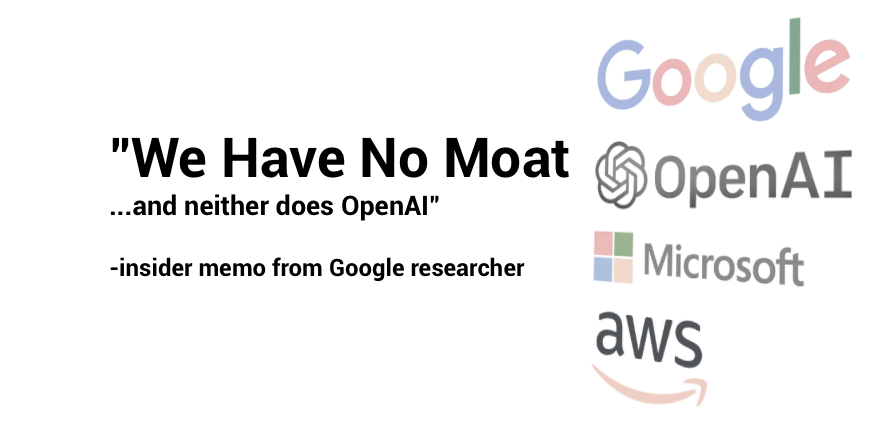Happy Friday. This week we bring you three stories to connect the dots between the industry trends and opportunities for community FIs. First, Google declares a détente with open-source AI capabilities. Next are how AI can radically change banking and financial services and why personalization is a great place to start.
1. The power of AI is in the data
SemiAnalysis published this week a memo purportedly from inside Google. Beyond the technical assessment, the document paints a picture of a vastly leveled playing field regarding big tech’s AI capability.
But holding on to a competitive advantage in technology becomes even harder now that cutting edge research in LLMs is affordable. Research institutions all over the world are building on each other’s work, exploring the solution space in a breadth-first way that far outstrips our own capacity. We can try to hold tightly to our secrets while outside innovation dilutes their value, or we can try to learn from each other.
Browsing through the models that people are creating in the image generation space, there is a vast outpouring of creativity, from anime generators to HDR landscapes. These models are used and created by people who are deeply immersed in their particular subgenre, lending a depth of knowledge and empathy we cannot hope to match.
Assuming the assessment to be correct, the main takeaways from an outside perspective:
- The infrastructure and algorithm of AI are being commoditized. Open source is reaching/has reached parity with the major providers.
- Companies’ unique 1st party data about their market and customers is becoming increasingly valuable.
2. The broad untapped use cases in banking and financial services for AI
The fintech firm at VC firm a16z writes on the breath of use cases in financial services that are ripe for disruption for the latest advances in generative AI.
While consumer fintech companies have achieved an enormous amount of success over the past 10 years, they haven’t yet fulfilled their most ambitious promise: to optimize a consumer’s balance sheet and income statement, without a human in the loop. This promise remains unfulfilled because user interfaces are unable to fully capture the human context that influences financial decisions or provide advice and cross-selling in a way that helps humans make appropriate tradeoffs.
Consumers tend to consider both utility and brand when making such decisions, and the interplay of these two factors makes it complicated to create an experience that can fully capture how to optimize this decision. This makes it difficult to provide best-in-class credit coaching, for example, without the involvement of a human employee.
LLMs provide a tidy solution to these problems with a better understanding and thus a better navigation of consumers’ financial decisions. These systems can answer questions (“Why is part of my portfolio in muni bonds?”), evaluate tradeoffs (“How should I think about duration risk versus yield?”), and ultimately factor human context into decision making (“Can you build a plan that’s flexible enough to help financially support my aging parents at some point in the future?”).
3. The psychological power of personalization
Personalized customer engagement is the shortest path within the landscape of opportunity for financial services. A noted buyer psychology expert Katelyn Bourgoin writes on why personalization is effective in her must-read newsletter. Katelyn looks at why this particular itch in our brains gets scratched from personalization, even in small ways.
Personalization creates a connection between buyers and brands.
- 56% of buyers prefer purchasing from retailers that recognize them by name.
- 65% of buyers prefer retailers that “know their purchase history.”
- 58% of buyers prefer retailers that make product recommendations based on past purchases.
People don’t even have to own the product for their personalization bias to kick in.
Even the perception of ownership has powerful psychological effects.
Once a prospect feels a sense of ownership over a product, they don’t want to give it up and they’re more likely to buy.
It’s easy to say no to the idea of a pair of socks with your dog’s face on them… until you see the socks

That’s a wrap for the week. If all of this AI discussion worries you, you’re not alone. Thank you for reading to the bottom. What did you think? Drop us a line at blog@mindspaninc.com.

